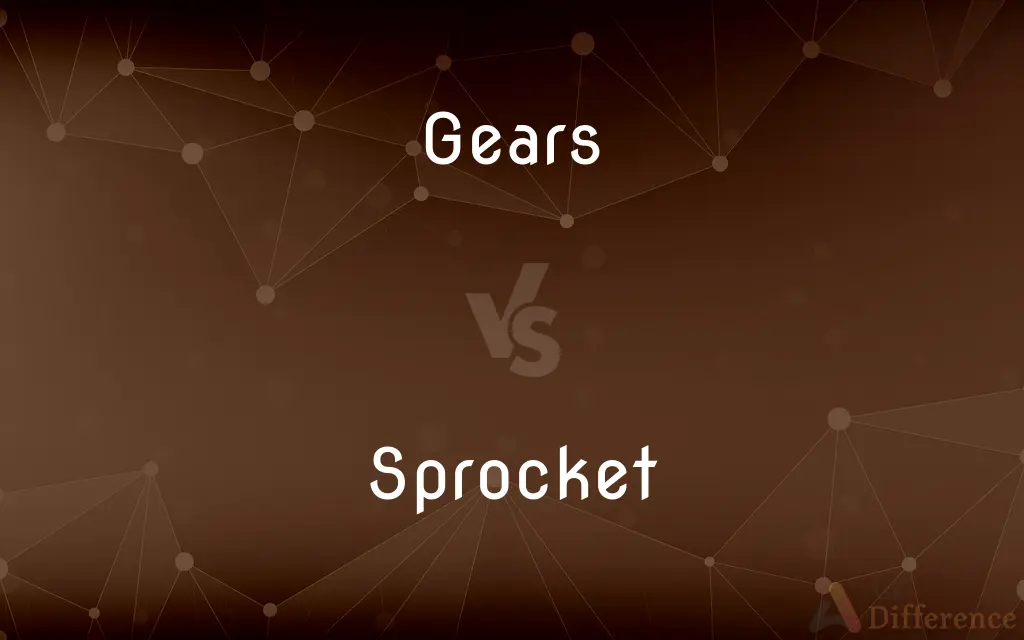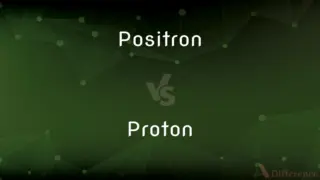Gears vs. Sprocket — What's the Difference?
By Tayyaba Rehman — Updated on November 7, 2023
Gears are toothed wheels that mesh to transmit torque; sprockets engage chains in similar motion.

Difference Between Gears and Sprocket
Table of Contents
ADVERTISEMENT
Key Differences
Gears are toothed mechanical components that mesh with others to transmit torque to machinery, while a sprocket is a toothed wheel that engages with a chain or track. Gears often work in pairs to change the direction of motion and to increase or decrease speed and torque. On the other hand, sprockets are designed to work with a specific chain or track, ensuring that the motion is transferred smoothly and without slippage.
Gears can be found in numerous mechanisms, from watches to automotive transmissions, where precise control of motion is critical. Sprockets are commonly seen in bicycles and motorcycles, where a chain's movement is required to transfer power from the pedals or motor to the wheels. The design of gears is crucial for maintaining the correct timing and speed ratios between interconnected rotating parts, while sprockets are primarily concerned with the transfer of rotary motion.
In gears, the size and number of teeth determine the mechanical advantage and speed ratio. In sprockets, the dimensions and the tooth profile must match the chain or track to ensure a seamless transmission of power. Gears are typically part of complex gear trains that can include many meshing components, whereas sprockets usually engage with a single chain.
The material selection for gears is essential for ensuring durability and precision; materials range from plastics for low-load applications to hardened steel for high-torque applications. Sprockets also require durable materials, but the choice is influenced by the type of chain and the required strength-to-weight ratio. Gears need to maintain close tolerances to function correctly, whereas sprockets can have slightly looser tolerances since the chain can accommodate some variation.
In terms of maintenance, gears require lubrication to minimize wear and maintain efficiency. Sprockets also need regular lubrication, but in addition, the chain or track tension must be checked and adjusted to prevent excessive wear or slippage. Both gears and sprockets are subject to wear and must be inspected regularly to ensure reliable operation.
ADVERTISEMENT
Comparison Chart
Function
Transmit torque between shafts
Engage chains for power transmission
Engagement
Mesh with other gears
Match with chains or tracks
Application
Precise control in machines
Chain-driven systems like bikes
Design Complexity
Part of complex gear trains
Usually engage with a single chain
Material
Ranges from plastics to steel
Chosen based on chain type
Compare with Definitions
Gears
Integral parts of a transmission system.
The car's gears ground loudly, indicating a need for repair.
Sprocket
Part of a chain drive system.
The motor's sprocket turned smoothly, propelling the conveyor belt.
Gears
Mechanical components with teeth for torque transmission.
The clock's gears interlocked precisely, keeping accurate time.
Sprocket
A cogwheel that interacts with a moving perforation or track.
The film projector's sprocket pulled the film through steadily.
Gears
Used metaphorically to represent engagement or readiness.
Once the team got their gears in motion, productivity soared.
Sprocket
A wheel with teeth for chain engagement.
The bike's sprocket was worn, needing replacement.
Gears
Elements in a machine that determine speed ratios.
Shifting gears, the cyclist increased his speed uphill.
Sprocket
A profiled wheel that drives or is driven by a chain.
The sprocket's teeth fit perfectly with the chain links.
Gears
A toothed machine part, such as a wheel or cylinder, that meshes with another toothed part to transmit motion or to change speed or direction.
Sprocket
Used in various machines to transfer motion.
The motorcycle's power is transferred through the sprocket.
Gears
A complete assembly that performs a specific function in a larger machine.
Sprocket
A sprocket, sprocket-wheel or chainwheel is a profiled wheel with teeth that mesh with a chain, track or other perforated or indented material. The name 'sprocket' applies generally to any wheel upon which radial projections engage a chain passing over it.
Gears
A transmission configuration for a specific ratio of engine to axle torque in a motor vehicle.
Sprocket
Any of various toothlike projections arranged on a wheel rim to engage the links of a chain.
Gears
Equipment, such as tools or clothing, used for a particular activity
Fishing gear.
Sprocket
A wheel having such teeth along its rim. Also called sprocket wheel.
Gears
Clothing and accessories
The latest gear for teenagers.
Sprocket
A cylinder with a toothed rim that engages in the perforations of photographic or movie film to pull it through a camera or projector.
Gears
Personal belongings, including clothing
Keeps her gear in a trunk.
Sprocket
(mechanical engineering) A toothed wheel that enmeshes with a chain or other perforated band.
Gears
The harness for a horse.
Sprocket
The tooth of such a wheel.
Gears
A ship's rigging.
Sprocket
(architecture) A flared extension at the base of a sloped roof.
Gears
A sailor's personal effects.
Sprocket
A placeholder name for an unnamed, unspecified, or hypothetical manufactured good or product.
Suppose we have a widget factory that produces 100 widgets per year, and a sprocket factory that produces 200 sprockets per year.
Gears
To equip with gears.
Sprocket
A tooth or projection, as on the periphery of a wheel, shaped so as to engage with a chain.
Gears
To connect by gears.
Sprocket
Roller that has teeth on the rims to pull film or paper through
Gears
To put into gear.
Sprocket
Thin wheel with teeth that engage with a chain
Gears
To adjust or adapt so as to make suitable
Geared the speech to a conservative audience.
Sprocket
Tooth on the rim of gear wheel
Gears
To provide with gear; equip.
Gears
To come into or be in gear.
Gears
To shift a transmission
Geared down to take the curve.
Gears
To become adjusted so as to fit or blend.
Gears
Plural of gear
Gears
Wheelwork consisting of a connected set of rotating gears by which force is transmitted or motion or torque is changed;
The fool got his tie caught in the geartrain
Gears
Devices that can change the direction of force.
The engineer designed the gears to reverse the motor's rotation.
Common Curiosities
What are gears?
Gears are rotating machine parts with cut teeth designed to mesh with another toothed part to transmit torque.
How do gears work?
Gears work by interlocking their teeth with the teeth of another gear, thus transferring force and motion between gear shafts.
Can gears change the direction of motion?
Yes, gears can change the direction of motion when they are arranged to mesh at right angles.
Where are gears commonly used?
Gears are used in various machines, including clocks, vehicles, and industrial machinery, to adjust speed and torque.
How do you choose the right gear for a machine?
The right gear is chosen based on the required speed, torque, and direction of force transmission.
Can sprockets be used with any chain?
No, sprockets must be matched with a specific chain size and type to function properly.
What is a sprocket?
A sprocket is a toothed wheel that meshes with a chain or track, used in bicycles, motorcycles, and conveyor systems.
How do sprockets differ from gears?
Sprockets are designed to engage with a chain or track, while gears are designed to mesh with other gears.
Do gears and sprockets have the same tooth profile?
No, gears have a specific profile designed for meshing with gears, while sprockets have a profile designed for chains.
Can gears be used without lubrication?
Gears typically require lubrication to prevent wear and tear and to operate smoothly, although some materials or coatings can reduce this need.
What materials are sprockets made of?
Sprockets are commonly made from metals like steel or aluminum but can also be made from plastics for lighter applications.
What happens if a sprocket's teeth wear down?
If a sprocket's teeth wear down, it can slip or jump over the chain, causing malfunction or damage to the system.
Are there any safety concerns with sprockets?
Yes, sprockets can pose safety risks if guards are not in place, as fingers or clothing can get caught in the chain drive.
How often do sprockets need maintenance?
Sprockets require regular lubrication and adjustment to maintain proper chain tension and prevent wear.
Are sprockets interchangeable between different devices?
Sprockets are not generally interchangeable unless the devices use the same type and size of chain.
Share Your Discovery

Previous Comparison
Positron vs. Proton
Next Comparison
Asphalt vs. MacadamAuthor Spotlight
Written by
Tayyaba RehmanTayyaba Rehman is a distinguished writer, currently serving as a primary contributor to askdifference.com. As a researcher in semantics and etymology, Tayyaba's passion for the complexity of languages and their distinctions has found a perfect home on the platform. Tayyaba delves into the intricacies of language, distinguishing between commonly confused words and phrases, thereby providing clarity for readers worldwide.
















































